new posts in all blogs
Viewing: Blog Posts Tagged with: Abrams, Most Recent at Top [Help]
Results 1 - 25 of 80
How to use this Page
You are viewing the most recent posts tagged with the words: Abrams in the JacketFlap blog reader. What is a tag? Think of a tag as a keyword or category label. Tags can both help you find posts on JacketFlap.com as well as provide an easy way for you to "remember" and classify posts for later recall. Try adding a tag yourself by clicking "Add a tag" below a post's header. Scroll down through the list of Recent Posts in the left column and click on a post title that sounds interesting. You can view all posts from a specific blog by clicking the Blog name in the right column, or you can click a 'More Posts from this Blog' link in any individual post.

By:
Betsy Bird,
on 7/21/2016
Blog:
A Fuse #8 Production
(
Login to Add to MyJacketFlap)
JacketFlap tags:
Reviews,
middle grade fantasy,
funny books,
Best Books,
abrams,
Amulet Books,
Amy Ignatow,
middle school novels,
middle school fantasy,
funny fantasy,
Best Books of 2016,
Reviews 2016,
2016 middle grade fantasy,
2016 middle grade fiction,
2016 funny books,
2016 middle school fiction,
Add a tag
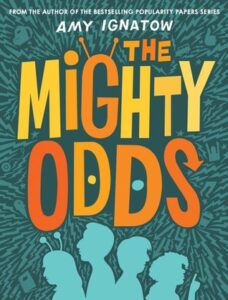 The Mighty Odds
The Mighty Odds
By Amy Ignatow
Amulet Books (an imprint of Abrams)
$15.95
ISBN: 978-1-4197-1271-5
Ages 10 and up
On shelves September 13th
If you could have one weird superpower, what would it be? Not a normal one, mind you. We’re not doing a flight vs. invisibility discussion here. The power would have to be extraordinary and odd. If it’s completely useless, all the better. Me? I think I’d like my voice to be same as the voice you hear in your head when you’re reading something. You know that voice? That would be my superpower. A good author can crank this concept up to eleven if they want to. Enter, Amy Ignatow. She is one of the rare authors capable of making me laugh out loud at the back covers of her books. For years she’s penned The Popularity Papers to great success and acclaim. Now that very realistic school focus is getting a bit of a sci-fi/fantasy kick in the pants. In The Mighty Odds, Ignatow takes the old misfits-join-together-to-save-the-world concept and throws in a lot of complex discussions of race, middle school politics, bullying, and good old-fashioned invisible men. The end result is a 21st century superhero story for kids that’s keeps you guessing every step of the way.
A school bus crashes in a field. No! Don’t worry! No one is killed (that we can tell). And the bus was just full of a bunch of disparate kids without any particular connection to one another. There was the substitute teacher and the bus driver (who has disappeared). And there was mean girl Cookie (the only black girl in school and one of the most popular), Farshad (nicknamed “Terror Boy” long ago by Cookie), Nick (nerdy and sweet), and Martina (the girl no one notices, though she’s always drawing in her sketchbook). After the accident everything should have just gotten back to normal. Trouble is, it didn’t. Each person who was on or near the bus when the accident occurred is a little bit different. It might be a small thing, like the fact that Martina’s eyes keep changing color. It might be a weird thing, like how Cookie can read people’s minds when they’re thinking of directions. It might be a powerful thing, like Farad’s super strength in his thumbs. Or it might be a potentially powerful, currently weird thing like Nick’s sudden ability to teleport four inches to his left. And that’s before they discover that someone is after them. Someone who means them harm.
Superhero misfits are necessarily new. Remember Mystery Men? This book reminded me a lot of that old comic book series / feature film. In both cases superpowers are less a metaphor and more a vehicle for hilarity. I read a lot of books for kids but only once in a while do I find one enjoyable enough to sneak additional reads of on the sly. This book hooked me fairly early on, and I credit its sense of humor for that. Here’s a good example of it. Early in the book Cookie and a friend are caught leaving the field trip for their own little side adventure. The kids in their class speculate what they got up to and one says that clearly they got drunk. Farshad’s dry wit then says, “… because two twelve-year-olds finding a bar in Philadelphia that would serve them at eleven A.M. was completely plausible.” Add in the fact that they go to “Deborah Read Middle School” (you’ll have to look it up) and I’m good to go.
Like I’ve said, the book could have just been another fun, bloodless superhero misfit storyline. But Ignatow likes challenges. When she wrote the Popularity Papers books she gave one of her two heroines two dads and then filled the pages with cursive handwriting. Here, her heroes are a variety of different races and backgrounds, but this isn’t a Benetton ad. People don’t get along. Cookie’s the only black kid in her school and she’s been very careful to cement herself as popular from the start. When her mom moved them to Muellersville, Cookie had to be careful to find a way to become “the most popular and powerful person in school.” Martina suggests at one point that she likes being angry, and indeed when the world starts to go crazy on her the thing that grounds her, if only for a moment, is anger. And why shouldn’t she be angry? Her mom moved her away from her extended family to a town where she knew no one, and then her mother married a guy with two kids fairly fast. Cookie herself speculates about the fact that she probably has more in common with Farshad than she’d admit. “He was the Arab Kid, just like Cookie was the Black Girl and Harshita Singh was the Indian Girl and Danny Valdez was the Hispanic Guy and Emma Lee was the Asian Chick. They should have all formed a posse long ago and walked around Muellersville together, just to freak people out.” Cookie realizes that she and Farshad need to have one another’s backs. “It was one thing to be a brown person in Muellersville and another to be a brown person in Muellersville with superpowers.” At this point in time Ignatow doesn’t dig any deeper into this, but Cookie’s history, intentions, and growth give her a depth you won’t find in the usual popular girl narrative.
For the record, I have a real appreciation for contemporary books that feature characters that get almost zero representation in books. For example, one of the many things I love about Tom Angleberger’s The Qwikpick Papers series is that one of the three heroes is Jehovah’s Witness. In this book, one of the kids that comes to join our heroes is Amish. Amish kids are out there. They exist. And they almost never EVER get heroic roles in stories about a group of friends. And Abe doesn’t have a large role in this book, it’s true, but it’s coming.
Having just one African-American in the school means that you’re going to have ignorant other characters. Cookie has done a good job at getting the popular kids in line, but that doesn’t mean that everyone is suddenly enlightened. Anyone can be tone deaf. Even one of our heroes, which in this case means Nick’s best friend, the somewhat ADD, always chipper Jay. Now I’ve an odd bit of affection for Jay, and not just because in his endless optimism he honestly thinks he’ll get permission to show his class Evil Dead Two on the field trip bus (this may also mark the first time an Evil Dead film has been name dropped in a middle grade novel, by the way). The trouble comes when he talks about Cookie. He has a tendency to not just be tone deaf but veering into really racially questionable territory when he praises her. Imagine a somewhat racist Pepe Le Pew. That’s Jay. He’s a small town kid who’s only known a single solitary black person his entire life and he’s enamored with her. Still, that’s no excuse for calling her “my gorgeous Nubian queen” or saying someday they’ll “make coffee-colored babies.” I expected a little more a comeuppance for Jay and his comments, but I suppose that’ll have to wait for a future book in the series. At the very least, his words are sure to raise more than few eyebrows from readers.
Funny is good. Great even. But funny doesn’t lift a middle grade book out of the morass of other middle grade books that are clogging up the bookstores and libraries of the world. To hit home you need to work just a smidgen of heart in there. A dose of reality. Farad’s plight as the victim of anti-Muslim sentiment is very real, but it’s also Nick’s experiences with his dying/dead father that do some heavy lifting. As you get to know Nick, Ignatow sprinkles hints about his life throughout the text in a seamless manner. Like when Nick is thinking about weird days in his life and flashes back to the day after his dad’s funeral. He and his mom had “spent the entire day flopped on the couch, watching an impromptu movie marathon of random films (The Lord of the Rings, They Live, Some Like It Hot, Ghostbusters, and Babe) and eating fancy stuff from the gift baskets that people had sent, before finally getting up to order pizza.” There’s a strong smack of reality in that bit, and there are more like it in the book. A funny book that sucker punches your heart from time to time makes for good reading.
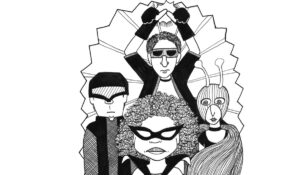 Lest we forget, this is an illustrated novel. Ignatow makes the somewhat gutsy choice of not explaining the art for a long time. Long before we even get to know Martina, we see her in various panels and spreads as an alien. In time, we learn that the art in this book is all her art, and that she draws herself as a Martian because that’s what her sister calls her. Not that you’ll know any of this for about 125 pages. The author makes you work to get at that little nugget of knowledge. By the way, as a character, Martina the artist is fascinating. She’s sort of the Luna Lovegood of the story. Or, as Nick puts it, “She had a sort of almost absentminded way of saying things that shouldn’t have been true but probably were.” There is one tiny flub in the art when Martina draws all the kids as superheroes and highlights Farshad’s thumbs, though at that point in the storyline Martina wouldn’t know that those are his secret weapons. Other than that, it’s pretty perfect.
Lest we forget, this is an illustrated novel. Ignatow makes the somewhat gutsy choice of not explaining the art for a long time. Long before we even get to know Martina, we see her in various panels and spreads as an alien. In time, we learn that the art in this book is all her art, and that she draws herself as a Martian because that’s what her sister calls her. Not that you’ll know any of this for about 125 pages. The author makes you work to get at that little nugget of knowledge. By the way, as a character, Martina the artist is fascinating. She’s sort of the Luna Lovegood of the story. Or, as Nick puts it, “She had a sort of almost absentminded way of saying things that shouldn’t have been true but probably were.” There is one tiny flub in the art when Martina draws all the kids as superheroes and highlights Farshad’s thumbs, though at that point in the storyline Martina wouldn’t know that those are his secret weapons. Other than that, it’s pretty perfect.
It’s also pretty clearly middle school fare, if based on language alone. You’ve got kids leaving messages on cinderblocks that read “Nolite te bastardes carborundorum” or “Don’t let the bastards get you down.” That may be the most realistic middle school detail I’ve read in a book in a long time. The bullying is systematic, realistic, and destructive (though that’s never clear to the people doing the bullying). A little more hard core than what an elementary school book might discuss. And Cookie is a superb bully. She’s honestly baffled when Farad confronts her about what she’s done to him with her rumors.
A word of warning to the wise: This is clearly the first book in a longer series. When you end this tale you will know the characters and know their powers but you still won’t know who the bad guys are exactly, why the kids got their powers (though the bus driver does drop one clue), or where the series is going next. For a story where not a lot of time passes, it really works the plotting and strong characterizations in there. I like middle grade books that dream big and shoot for the moon. “The Mighty Odds” does precisely that and also works in some other issues along the way. Just to show that it can. Great, fun, silly, fantastical fantasy work. A little smarter and a little weirder than most of the books out there today.
On shelves September 13th.
Source: Galley sent from publisher for review.
Readalikes:
Professional Reviews:

Taking the idea of awareness and screwing with it from multiple vantage points — self-awareness, awareness of the space around you, familial awareness, scientific awareness, societal awareness — Aama addresses, among other things, the notion of a hive mind and presents mankind as a damaged entity, one in which each part is out of sync […]
First Flight Around the World: The Adventures of the American Fliers Who Won the Race by Tim Grove. Abrams Books For Young Readers. 2015. Library copy. YALSA Nonfiction Finalist.
by Tim Grove. Abrams Books For Young Readers. 2015. Library copy. YALSA Nonfiction Finalist.
 It's About: In 1924, the race was on -- to see what country would be the first to fly around the world. The United States's entry into the race was a team of eight men and four planes. The subtitle of the book reflects that this is not a book asking who won -- it was the Americans -- but rather, how.
It's About: In 1924, the race was on -- to see what country would be the first to fly around the world. The United States's entry into the race was a team of eight men and four planes. The subtitle of the book reflects that this is not a book asking who won -- it was the Americans -- but rather, how.
The Good: First Flight Around the World takes place so early in the era of flight; the Wright Brothers flight was just over twenty years before. While technology had increased in those years, the US was no longer the leader in flight. Public support and funding was needed; what better way to get both than the be the first to fly around the globe?
Planes, pilots, and mechanics were prepared and selected. The route was planned; which direction to fly, based on weather, temperature, location; where and how would the planes land? Were those countries friends? How far could a plane fly? Where should refueling spots be? How much weight could be carried?
Planes were open cockpit; there was no radar. Radios had such limited range that they weren't included in the list of supplies. Stops ranged from small villages to large cities, and sometimes diplomatic relations were as important as repairing planes.
Because one of the items taken along was a camera, there are plenty of original photographs. Maps and photos and documents help bring the flight to life.
Newspapers were full of the news of the flights and the flyers; they were famous in their time. As the book ended with their triumph return to the United States and the final legs of their journey, I couldn't help but think about how unknown they are in the present time. How quickly things can change; none of these names were familiar. (And yes, I did wonder what happened to the pilots after, and wish there had been more about what happened to them after 1924.)
Two of the YALSA Nonfiction finalists done, three more to go!
Amazon Affiliate. If you click from here to Amazon and buy something, I receive a percentage of the purchase price.
© Elizabeth Burns of A Chair, A Fireplace & A Tea Cozy



By: JOANNA MARPLE,
on 10/21/2015
Blog:
Miss Marple's Musings
(
Login to Add to MyJacketFlap)
JacketFlap tags:
Interview,
children's books,
publishing,
lego,
Abrams,
Hatchette,
Marcie Colleen,
Jonathan Lopes,
Barbar,
Ghostgirl series by Tonya Hurely,
production management,
Readerlink Distribution Sevices LLC,
Add a tag
I have known Jonathan a number of years as he is married to one of my best friends (author, Marcie Colleen.) I had the joy of attending their wedding just over twelve months ago in Gowanus (Brooklyn.) When I first … Continue reading →

By:
Heidi MacDonald,
on 10/5/2015
Blog:
PW -The Beat
(
Login to Add to MyJacketFlap)
JacketFlap tags:
peanuts,
alan turing,
Abrams,
chip kidd,
Adventure Time,
jim ottaviani,
Paul Levitz,
Leland Purvis,
Top News,
SDCC '15,
joh nleguizamo,
Add a tag
MORE things to do and get signed at NYCC, with lots ofr preveiws of Abrams Spring 2016 line all at booth #2228 and 2016 Abrams calendars with every purchase over $50.00 while supplies last (limited one per customer). And advance copies of the above book about Alan Turing by Jim Ottaviani and Leland Purvis. Advance […]

by Nikki McClure (Abrams, 2015)

This is one of those books where the cover convinces you that you’ll love it. It’s both bright and cozy. Spare and warm.
A teensy giraffe peeks out of this boy’s hiding spot and you can see its smiling face, but only eager anticipation in this boy’s eyes.
Open.


This is my kind of kid. It looks like a grownup is over his shoulder, offering an open door and a pair of shoes. But he’s got a tower of bricks, a colander kingdom, and the very best pair of pajamas.
In is best.
Until out is.



And when out is cold and wet, in you go.

Nikki McClure’s paper cuts are intricate and exquisite, but they are also all-embracing. Not common artwork, but a reminder of the universal comforts of childhood and play and home.
A stark black and vibrant yellow are perfect patches of color to explore these opposing wishes. They balance, they tug, and they leave enough room for us to journey with him. By day and until nightfall.
In and out.
A perfect choice to celebrate curiosity, imagination, and the way we explore our world.
Another Nikki McClure favorite is here!


January 2016
Abrams Comicarts
Animated TV series don’t often receive lavish ‘art of’ book treatment, but Adventure Time is unlike your average TV show. Next Tuesday, October 14, Abrams will release the massive 352-page Adventure Time: The Art of Ooo, documenting the show’s visual and creative process. The book was authored and designed by Cartoon Brew’s very own Chris McDonnell, who is the editor of our popular Artist of the Day section. The following images represent a small sample of the 500-plus images that will be included in the book. Click to enlarge and read the captions. Pre-order Adventure Time: The Art of Ooo on Amazon for $24.92. (All images TM and © 2014 Cartoon Network.)

By:
Betsy Bird,
on 8/21/2014
Blog:
A Fuse #8 Production
(
Login to Add to MyJacketFlap)
JacketFlap tags:
middle grade graphic novels,
graphic novel memoirs,
Best Books of 2014,
Reviews 2014,
2014 reviews,
2014 graphic novels,
2014 memoirs,
Reviews,
graphic novels,
Cece Bell,
Best Books,
abrams,
Amulet Books,
Add a tag
 El Deafo
El Deafo
By Cece Bell
Amulet (an imprint of Abrams)
$21.95
ISBN: 978-1-4197-1020-9
Ages 9-12
On shelves September 2nd
We appear to exist in a golden age of children’s graphic novel memoirs. Which is to say, there are three of them out this year (El Deafo, Sisters, and The Dumbest Idea Ever). How to account for the sudden tiny boom? If I were to harbor a guess I’d say it has something to do with publishers realizing that the genre can prove a profitable one (hat tip then to Smile). We’re beginning to enter into an era where the bulk of the gatekeepers out there, be they parents or teachers or librarians, are viewing comics not as a corrupting influence but rather as a new literary form with which to teach. Memoirs are particularly interesting and have proven to be a wonderful way to slowly ease kids into the big beautiful world of nonfiction. That said, not everyone’s youth is worthy of a retelling. To tell a memoir well you need to have a narrative arc of some sort. One that doesn’t feel forced. For CeCe Bell, her first foray into graphic novels is also telling the story of her youth. The result, El Deafo, is a remarkable look at a great grand question (What to do when you can no longer hear and feel different from everyone you know?) alongside a smaller one that every kid will relate to (How do you find a good friend?). Bell takes the personal and makes it universal, an act that truly requires superhero skills.
Until the age of four CeCe was pretty much indistinguishable from any other kid. She liked her older siblings. She liked to sing to herself. But a sudden bout with meningitis and something changed for CeCe. All at once her hearing was gone. After some experimentation she was fitted with a Sonic Ear (a device that enabled her to hear her teacher’s voice) and started attending classes with other kids like herself. A family trip to a smaller town, however, meant going to a new school and trying to make new friends. When faced with problems she reverts to her pretend superhero self, El Deafo. With subtlety Bell weaves in knowledge of everything from reading lips and sign language to the difficulties of watching un-captioned television. At the same time the book’s heart lies with a single quest: That of finding the absolute perfect friend.
 The rise of the graphic novel memoir of a cartoonist’s youth with a child audience in mind really hit its stride when Raina Telgemeier wrote, Smile. That dire accounting of her at times horrific dental history paved the way for other books in the same vein. So where did my library choose to catalog that graceful memoir? In the biography section? No. In the graphic novel section? Not initially, no. For the first year of its existence it was shelved in nonfiction under the Dewey Decimal number 617.645 T. That’s right. We put it in the dental section. So it was with great trepidation that I looked to see where El Deafo would end up. Would it be in the section on the hearing impaired or would the catalog understand that this book is about so much more than the Sonic Ear? As it happens, the book appears to be primarily cataloged as a memoir more than anything else. Sure the information in there about the deaf community and other aspects of living as someone hearing impaired are nonfiction, but the focus of the story is always squarely on CeCe herself.
The rise of the graphic novel memoir of a cartoonist’s youth with a child audience in mind really hit its stride when Raina Telgemeier wrote, Smile. That dire accounting of her at times horrific dental history paved the way for other books in the same vein. So where did my library choose to catalog that graceful memoir? In the biography section? No. In the graphic novel section? Not initially, no. For the first year of its existence it was shelved in nonfiction under the Dewey Decimal number 617.645 T. That’s right. We put it in the dental section. So it was with great trepidation that I looked to see where El Deafo would end up. Would it be in the section on the hearing impaired or would the catalog understand that this book is about so much more than the Sonic Ear? As it happens, the book appears to be primarily cataloged as a memoir more than anything else. Sure the information in there about the deaf community and other aspects of living as someone hearing impaired are nonfiction, but the focus of the story is always squarely on CeCe herself.
The real reason I found the book as compelling as I did was due in large part to the way in which Bell tackles the illogical logic of childhood friendships. So many kids are friends thanks to geographical convenience. You’re my age and live within a certain radius of my home? We’re besties! And Bell’s hearing impaired state is just a part of why she is or is not friends with one person or another. Really, the true arc of the story isn’t necessarily CeCe coming to terms with the Sonic Ear, but rather how she comes to terms with herself and, in doing so, gets the best possible friend. It’s like reading a real life Goldilocks story. This friend is too bossy. This friend is too fixated on Cece’s hearing. But this friend? She’s juuuuuust right.
 So why bunnies? Bell could easily have told her story with human beings. And though the characters in this book appear to be anthropomorphized rabbits (reminding me of nothing so much as when guest stars would appear on the children’s television program Arthur) there is no particular reason for this. They never mention a particular love of carrots or restrict their movements to hop hop hopping. They are, however, very easy on the eyes and very enticing. This book was sitting on my To Be Reviewed shelf when my three-year-old waltzed over and plucked it for her own perusal. The bunnies are accessible. In fact, you completely forget that they even are bunnies in the course of reading the book. You also fail to notice after a while how beautifully Bell has laid out her comic panels too. The sequential storytelling is expertly rendered, never losing the reader or throwing you out of the story. One librarian I spoke to also mentioned how nice it was to see that the dream sequences with El Deafo are always clearly delineated as just that. Dream sequences. Fantasy and reality are easily distinguishable in this novel. No mean feat when everyone has a twitchy little nose.
So why bunnies? Bell could easily have told her story with human beings. And though the characters in this book appear to be anthropomorphized rabbits (reminding me of nothing so much as when guest stars would appear on the children’s television program Arthur) there is no particular reason for this. They never mention a particular love of carrots or restrict their movements to hop hop hopping. They are, however, very easy on the eyes and very enticing. This book was sitting on my To Be Reviewed shelf when my three-year-old waltzed over and plucked it for her own perusal. The bunnies are accessible. In fact, you completely forget that they even are bunnies in the course of reading the book. You also fail to notice after a while how beautifully Bell has laid out her comic panels too. The sequential storytelling is expertly rendered, never losing the reader or throwing you out of the story. One librarian I spoke to also mentioned how nice it was to see that the dream sequences with El Deafo are always clearly delineated as just that. Dream sequences. Fantasy and reality are easily distinguishable in this novel. No mean feat when everyone has a twitchy little nose.
Maybe we’ve peaked. Maybe we’re seeing as many graphic memoirs for kids as we’ll ever see in a given year. But that can’t be, can it? We all have stories to tell, no matter what our upbringing looked like. There’s always some element in our past that’s relatable to a wide audience. It’s the clever author that knows how to spin that element into a storyline worthy of a younger audience. There isn’t a jot of doubt in my mind that CeCe Bell’s book is going to be vastly beloved by nearly every child that picks it up. Engaging and beautifully drawn, to say nothing of its strength and out-and-out facts, El Deafo is going to help set the standard for what a memoir for kids should be. Infinitely clever. Undeniably fun. Don’t miss it.
On shelves September 2nd.
Source: Galley sent from publisher for review.
Like This? Then Try:


By:
Betsy Bird,
on 7/15/2014
Blog:
A Fuse #8 Production
(
Login to Add to MyJacketFlap)
JacketFlap tags:
Reviews,
nonfiction,
nonfiction picture books,
Best Books,
abrams,
Latino children's books,
Duncan Tonatiuh,
Latin American picture books,
Best Books of 2014,
Reviews 2014,
2014 reviews,
2014 nonfiction,
2015 Sibert Award contender,
Add a tag
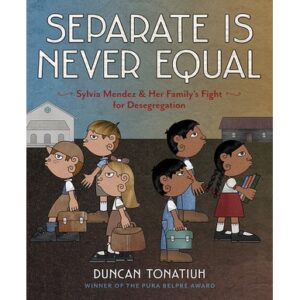 Separate is Never Equal: Sylvia Mendez and Her Family’s Fight for Desegretation
Separate is Never Equal: Sylvia Mendez and Her Family’s Fight for Desegretation
By Duncan Tonatiuh
Harry N. Abrams
$18.95
ISBN: 978-1419710544
Ages 7-12
On shelves now
If I blame my childhood education for anything I suppose it would be for instilling in me the belief that the history worth learning consisted of a set of universally understood facts. One event would be more worthy of coverage than another. One person better positioned for a biography than another. It was only in adulthood that I started to understand that the history we know is more a set of decisions made decades and decades ago by educators than anything else. Why were weeks and weeks of my childhood spent learning about The American Revolution but only a day on the Vietnam War? Why did we all read biographies of Thomas Edison but never about Nicolas Tesla? And why did it take me 36 years before someone mentioned the name of Sylvia Mendez to me? Here we have a girl with a story practically tailor made for a work of children’s nonfiction. Her tale has everything. Villains and heroes (her own heroic parents, no less). Huge historical significance (there’d be no Brown v. Board of Education without Sylvia). And it stars Latino-Americans. With the possible exception of Cesar Chavez, my education was pretty much lacking in any and all experience with Latino heroes in America. I’m therefore pleased as punch that we’ve something quite as amazing as Separate is Never Equal to fill in not just my gaps but the gaps of kids all over our nation.
Sylvia is going home in tears. Faced with teasing at her new school she tells her mother she doesn’t want to go back. Gently, her mother reminds her that teasing or no, this is exactly what the family fought so hard for for three long years. In 1944 the Mendez family had moved to Westminster, California. When the first day of school approached their Aunt drove five of the kids to the nearby public school. Yet when they arrived she was told that her children, with their light skin and brown hair could attend but that Sylvia and her brothers would have to go to “the Mexican school”. Faced with hugely inferior conditions, the Mendez family decides to fight back. They are inspired by a lawsuit to integrate the public pools and so they hire the same lawyer to take on their case. In court they hear firsthand the prejudices that the superintendent of their district holds dear, but ultimately they win. When that decision is appealed they take it to the state court, and win once more. Remembering all this, Sylvia returns to school where, in time, she makes friends from a variety of different backgrounds. Backmatter consists of an extensive Author’s Note, a Glossary, a Bibliography, additional information About the Text, and an Index.
 When I say that Sylvia’s story adapts perfectly to the nonfiction picture book form, I don’t want to downplay what Tonatiuh has done here. To tell Sylvia’s story accurately he didn’t have a single source to draw upon. Instead the book uses multiple sources, from court transcripts and films to books, websites, articles, and reports. Culling from all of this and then transferring it into something appropriate and interesting (that is key) for young readers is a worthy challenge. That Tonatiuh pulls it off is great, but I wonder if he could have done it if he hadn’t interviewed Sylvia Mendez herself in October 2012 and April 2013. Those who know me know that I’m a stickler for non-invented dialogue in my children’s works of nonfiction. If you can’t tell a real story without making up dialogue from real people then your book isn’t worth a lick. At first, it appears that Tonatiuh falls into the same trap, with Sylvia wondering some things and her family members saying other. Look at the backmatter, however, and you’ll see a note “About the Text”. It says that while the trial dialogue comes from court transcripts, the rest of the book came from conversations with Sylvia herself. So if she says her parents said one thing or she thought/pondered another, who are we to doubt her? Well played then.
When I say that Sylvia’s story adapts perfectly to the nonfiction picture book form, I don’t want to downplay what Tonatiuh has done here. To tell Sylvia’s story accurately he didn’t have a single source to draw upon. Instead the book uses multiple sources, from court transcripts and films to books, websites, articles, and reports. Culling from all of this and then transferring it into something appropriate and interesting (that is key) for young readers is a worthy challenge. That Tonatiuh pulls it off is great, but I wonder if he could have done it if he hadn’t interviewed Sylvia Mendez herself in October 2012 and April 2013. Those who know me know that I’m a stickler for non-invented dialogue in my children’s works of nonfiction. If you can’t tell a real story without making up dialogue from real people then your book isn’t worth a lick. At first, it appears that Tonatiuh falls into the same trap, with Sylvia wondering some things and her family members saying other. Look at the backmatter, however, and you’ll see a note “About the Text”. It says that while the trial dialogue comes from court transcripts, the rest of the book came from conversations with Sylvia herself. So if she says her parents said one thing or she thought/pondered another, who are we to doubt her? Well played then.
Librarians like myself spend so much time gushing over content and format that often we forget one essential element of any book: child-friendliness. It’s all well and good to put great information on picture book sized pages, but will any kid willingly read what you have? In this light, framing this book as a flashback was a clever move. Right from the start Tonatiuh places his story within the context of a child’s experience with mean kids. It’s a position a great many children can identify with, so immediately he’s established sympathy for the main character. She’s just like kids today . . . except a hero. At the end of the book we have photographs of the real participants, both then and now. As for the text itself, it’s very readable, keeping to the facts but, aided by the design and the art, eclectic enough to maintain interest.
 When we talk about Tonatiuh’s art it’s important to understand why he’s chosen the style that he has. In interviews the artist has discussed how his art is heavily influenced by ancient Mexican styles. As he said in an interview on the blog Seven Impossible Things Before Breakfast, “My artwork is very much inspired by Pre-Columbian art, especially by Mixtec codices from the 14th century. That is why my art is very geometric, my characters are always in profile, and their ears look a bit like the number three. My intention is to celebrate that ancient art and keep it alive.” Heads of participants are always shown from the side. This is combined with the decision to digitally insert real hair, of a variety of shades and hues and colors, onto the heads of the characters. The end result looks like nothing else out there. There are mild problems with it, since the neutral expression of the faces can resemble dislike or distaste. This comes up when Sylvia’s cousins are accepted into the nearest public school and she is not. Their faces are neutral but read the wrong way you might think they were coolly unimpressed with their darker skinned cousin. Still, once you’ve grown used to the style it’s hardly an impediment to enjoying the story.
When we talk about Tonatiuh’s art it’s important to understand why he’s chosen the style that he has. In interviews the artist has discussed how his art is heavily influenced by ancient Mexican styles. As he said in an interview on the blog Seven Impossible Things Before Breakfast, “My artwork is very much inspired by Pre-Columbian art, especially by Mixtec codices from the 14th century. That is why my art is very geometric, my characters are always in profile, and their ears look a bit like the number three. My intention is to celebrate that ancient art and keep it alive.” Heads of participants are always shown from the side. This is combined with the decision to digitally insert real hair, of a variety of shades and hues and colors, onto the heads of the characters. The end result looks like nothing else out there. There are mild problems with it, since the neutral expression of the faces can resemble dislike or distaste. This comes up when Sylvia’s cousins are accepted into the nearest public school and she is not. Their faces are neutral but read the wrong way you might think they were coolly unimpressed with their darker skinned cousin. Still, once you’ve grown used to the style it’s hardly an impediment to enjoying the story.
I think it’s important to stress for our children that when we talk about “integration”, we’re not just talking about African-American kids in the 1950s and 60s. Segregation includes Native Americans, Asian Americans, Latino Americans, and more. At one point in this book the Mendez family receives support from the NAACP, the Japanese American Citizens League, and the American Jewish Congress amongst others. Sylvia’s mother says, “When you fight for justice, others will follow”. For children to understand that freedom is never a done deal and that increased rights today means increased rights in the future is important. Books like Separate is Never Equal help drill the point home. There is absolutely nothing like this book on our shelves today. Pick it up when you want to hand a kid a book about Latino-American history that doesn’t involve Chavez for once. Required reading.
On shelves now.
Source: Final copy sent from publisher for review.
Like This? Then Try:

Ack! I had a whole post to do about 48 Hour Book Challenge prizes, but it's been one of those mornings. And by that I mean specifically one of those mornings where I sort of forgot that I have to get to work today for a meeting at 1:00 p.m. So, I'm going to do this in pieces and it won't be thorough and I'll remind everyone that 48 Hour Book Challenge isn't about the prizes, but an opportunity to share an experience as a community from the comfort of our own homes doing what we love to do, i.e. read, while also advocating, promoting, and otherwise celebrating diversity in children's and young adult literature in this year's connection to #WeNeedDiverseBooks.
Meanwhile, I'll be going back to my email later this afternoon to pull together the prizes that I know are there but don't have time to write about this very instant. But hey, how about the timing on this lovely package from Abrams Books today?

It's now a prize! See how easy it is to become a prize in the 48HBC? Have something you'd like to contribute? Drop me a line at MotherReader AT gmail DOT com.
Oh, and sign up to participate in the
48 Hour Book Challenge!
Links to material on Amazon.com contained within this post may be affiliate links for the Amazon Associates program, for which this site may receive a referral fee.

By:
Betsy Bird,
on 6/4/2014
Blog:
A Fuse #8 Production
(
Login to Add to MyJacketFlap)
JacketFlap tags:
Reviews,
reissues,
realistic fiction,
multicultural fiction,
abrams,
Amulet Books,
middle grade realistic fiction,
multicultural middle grade,
Tom Angleburger,
Reviews 2014,
2014 reviews,
2014 middle grade fiction,
2014 realistic fiction,
Add a tag
Here’s something I’ve never done before. For years I’ve been waiting for the moment when a book I loved and reviewed dipped out of print only to come back again. Since I’ve only been doing this gig since 2006 I wasn’t sure what that first book would be. Then, this year, I got my answer. Back in October of 2007 I reviewed a book by a newcomer going by the moniker of Sam Riddleberger. The book? The Qwikpick Adventure Society. I absolutely adored it, floored by some of the new things it was doing. Years passed and no one paid the book the appropriate amount of attention it deserved. Then Mr. Riddleberger decided to publish under his real name, Tom Angleberger, and next thing you know he’s written a little book by the name of The Strange Case of Origami Yoda and the world was never the same. What with his earlier efforts out of print and his name so incredibly bankable, I had high hopes that this might not be the last we’d seen of Mr. Riddleberger/Angleberger. Then this year, behold! Do mine eyes deceive me? No! It’s back! New cover, new title, old book.
So for today’s Flashback Wednesday we’re going to reprint that old review I did of the book . . . slightly modified. There are a couple mentions in the original review of things published “this year” that had to be updated. I’m going to keep the parts about the rarity of trailer park kids that aren’t abused, though in the comments of my original review Genevieve mentioned that The Higher Power of Lucky could be considered another alternative. Fair enough.
Enjoy!
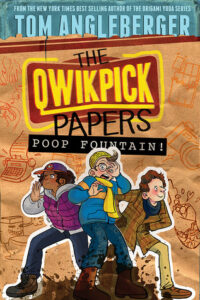 As a children’s book reviewer there is one fact that you must keep at the forefront of your mind at all times: You are not a kid. Not usually anyway. And because you are not a kid, you are not going to read a book the way a kid does. I keep talking in my reviews about how your own personal prejudices affect your interpretation of the book in front of you, and it’s bloody true. I mean, take scatological humor in all its myriad forms. When I read How to Eat Fried Worms as an adult, I didn’t actually expect the hero to eat worms (let alone 30+ of them). And when I read Out of Patience by Brian Meehl I really enjoyed it until the moment when the local fertilizer plant became… well, you’d have to read the book to grasp the full horror of the situation. Actually, Out of Patience was the title I kept thinking of as I got deeper and deeper into The Qwikpick Papers. Both books are funny and smart and both involve gross quantities of waste to an extent you might never expect. I am an adult. I have a hard time with poop. Poop aside (and that’s saying something) there’s a lot of great stuff going on in this book. It’s definitely a keeper, though it may need to win over its primary purchasing audience, adults.
As a children’s book reviewer there is one fact that you must keep at the forefront of your mind at all times: You are not a kid. Not usually anyway. And because you are not a kid, you are not going to read a book the way a kid does. I keep talking in my reviews about how your own personal prejudices affect your interpretation of the book in front of you, and it’s bloody true. I mean, take scatological humor in all its myriad forms. When I read How to Eat Fried Worms as an adult, I didn’t actually expect the hero to eat worms (let alone 30+ of them). And when I read Out of Patience by Brian Meehl I really enjoyed it until the moment when the local fertilizer plant became… well, you’d have to read the book to grasp the full horror of the situation. Actually, Out of Patience was the title I kept thinking of as I got deeper and deeper into The Qwikpick Papers. Both books are funny and smart and both involve gross quantities of waste to an extent you might never expect. I am an adult. I have a hard time with poop. Poop aside (and that’s saying something) there’s a lot of great stuff going on in this book. It’s definitely a keeper, though it may need to win over its primary purchasing audience, adults.
Lyle Hertzog is going to level with you right from the start. In this story he and his friends, “didn’t stop a smuggling ring or get mixed up with the mob or stop an ancient evil from rising up and spreading black terror across Crickenburg.” Nope. This is the story of Lyle, Dave, and Marilla and their club’s first adventure. The kids say that they’re The Qwikpick Adventure Society because they meet regularly in the break room of the local Qwikpick convenience store where Lyle’s parents work. When it occurs to the three that they’ll all be available to hang out on Christmas Day, they decide to do something extraordinary. Something unprecedented. And when Marilla discovers that the local “antiquated sludge fountain” at the Crickenburg sewer plant is about to be replaced, they know exactly what to do. They must see the poop fountain before it is gone. The result is a small adventure that is exciting, frightening, and very very pungent.
Someone once told me that this book reminded them of Stand By Me, “except no dead bodies and no Wil Wheaton.” They may be on to something there. Author Tom Angleberger works the relationships between the kids nicely. It’s a little hard to get into the heads of all the characters considering that we’re seeing everything through Lyle’s point of view, but the author does what he can. As for the “sludge fountain” itself, kids looking for gross moments will not be disappointed. You might be able to sell it to their parents with the argument that it’s actually rather informative and factual on this point (though I suggest that you play up the relationship aspect instead).
There are few kid-appropriate taboo topics out there, but if I was going to suggest one I might say it was the issue of class. Oh, you’ll get plenty of books where a kid lives a miserable life in a trailer park and gets teased by the rich/middle class kids in their class about it, sure. Now name all the books you can think of where the main characters live in a trailer park and that’s just their life. Or have parents that work in a convenience store and there isn’t any alcohol abuse, physical abuse, emotional abuse, etc. I swear, a kid who actually lived in a trailer park these days who tried to find a book containing kids like themselves would have to assume that abuse was the norm rather than the exception. So when I saw that both Lyle and Marilla lived in a trailer park and it wasn’t a big deal, that was huge for me. Also, sometimes a book with kids of different religions or ethnicities will make a big deal about the fact. Here, Lyle’s Christian, Dave’s Jewish, and Marilla’s a Jehovah’s Witness and not white but not identified as anything in particular. Quick! Name all the Jehovah’s Witnesses you’ve encountered in children’s books where the story wasn’t ALL about being a Jehovah’s Witness! Riddleburger is making people just people. What a concept.
I’ve been talking a lot this year about books that don’t slot neatly into categories. The kinds of books that mix genres and styles. The Qwikpick Papers will be classed as fiction, no question about it, but its prolific use of photographs certainly separates it from the pack. For example, there’s a moment when the kids are trying to figure out what to do for Christmas. One of them suggests opening a fifty-gallon drum of banana puree that’s been sitting behind an empty Kroger store and there, lo and behold, is an actual honest-to-goodness photograph of a rusty, decaying, very real banana puree barrel. I don’t know whether to hope that Mr. Angleberger took the picture years ago and was just itching for a chance to get to use it, or that he created the barrel himself for the sole purpose of including a photo of it in his book. I also enjoyed the hand-drawn portions. The comic strip All-Zombie Marching Band deserves mention in and of itself (though technically William Nicholson’s The Wind Singer did it too).
I say that the poop, the sheer amount of it, will turn off a lot of adults. At the same time though there are plenty of moments that will lure the grown-ups back in again. Particularly librarians. Particularly librarians that have ever attempted an origami craft with a bunch of kids. For these brave men and women Lyle’s line about the process of doing an unfamiliar animal will ring true. “You follow the instructions through like thirty-four steps and all of a sudden there’s this funky zigzag arrow and on the next page it has turned from a lump of paper into a horse with wings.” YES! Exactly! Thank you!
All in all, I’m a fan. The characters ring true, the dialogue is snappy, the unique format will lure in reluctant readers, and talk about a title custom made for booktalking! There’s not a kid alive today who wouldn’t want to read the book when confronted with the plot. It has ups. It has downs. It has a great sense of place and a whole lot of poop. Take all angles into consideration when considering this book. On my part, I like it and that is that.
On shelves now.
Like This? Then Try:
Other Blog Reviews of the Original:
Professional Reviews of the Original: Kirkus


By:
Chad W. Beckerman,
on 5/27/2014
Blog:
Mishaps and Adventures
(
Login to Add to MyJacketFlap)
JacketFlap tags:
Maggie lehrman,
design blog,
OTHERBOUND,
Corinne Duyvis,
Scbwi,
illustration,
Process,
cover design,
ABRAMS,
art direction,
Add a tag
It's been awhile since my last Cover evolution post after reading this blog you might forgive me. Usually, I give a couple short phrase about how each stage progressed. This post is a little different. Senior Editor
Maggie Lehrman and artist
Vince Natale will guide us through the cover evolution of
OTHERBOUND by Corinne Duyvis So let's get started.
First things first your need to know a little about the story.
Amara is never alone. Not when she’s protecting the cursed princess she unwillingly serves. Not when they’re fleeing across dunes and islands and seas to stay alive. Not when she’s punished, ordered around, or neglected.
She can’t be alone, because a boy from another world experiences all that alongside her, looking through her eyes.
Nolan longs for a life uninterrupted. Every time he blinks, he’s yanked from his Arizona town into Amara’s mind, a world away, which makes even simple things like hobbies and homework impossible. He’s spent years as a powerless observer of Amara’s life. Amara has no idea . . . until he learns to control her, and they communicate for the first time. Amara is terrified. Then, she’s furious.
All Amara and Nolan want is to be free of each other. But Nolan’s breakthrough has dangerous consequences. Now, they’ll have to work together to survive—and discover the truth about their connection.
So now let's hear from Maggie Lerhman, Senior Editor:
Otherboundis an incredibly original book, unlike anything I’d read before. It has interweaving perspectives, male and female POVs, a “normal” Arizona world and a “fantasy” world of the Dunelands, and characters that cross back and forth between them. The incredibly original can be tough to conceptualize in a book cover, since they tend not to have easy comparisons—and Chad and I found to be true in this case. We wanted to get across the idea of seeing the world through someone else’s eyes, and the general concept that there would be two worlds. But pretty much the rest of the cover was up in the air.
The first few comps that Chad and our designer Sara Corbett came up with tried a photographic/typographic approach. We liked the idea of having one eye open/one eye closed, but these felt a little slick, and they didn’t get across the strangeness and the seriousness of the central concept.
Then Sara and Chad came up with these, which were definitely more mysterious and very striking. Eyes are a natural thing to focus on—Corinne’s original title for the book was Blink. But in the end we felt there was something cold about these.
Our publisher expressed the problem concisely: These feel like science fiction, and we wanted to get across more of a sense of the magic and the fantastical.
By this point, we realized we needed to start from scratch…
but we’d spent a lot of time on what we’d done already, and our Advance Reader Copies were due to the printer. This was a crucial deadline so that booksellers and reviewers could start reading and talking about Corinne’s amazing book in advance of publication. We hate to have to print an ARC with a non-final cover, but sometimes it happens, and in this case, it was unavoidable. But Chad and Sara made an effort to find a typeface that read more “fantasy.”
Some of these felt “fantasy,” but a much more medieval-style fantasy that what Corinne had written. The Dunelands are a gritty, rough-edged world. There’s magic, but it’s an earthy, painful strain of magic, not a gowns-and-potions magic. The gothic feel of that type didn’t fit in with how I had pictured that world. Plus it didn’t hint at Nolan’s real-world environment at all—which is half of the book. We eventually went with this blocky interconnected type, which felt to me as if it had been carved out of stone.
We liked that type for the ARC, but for the final cover, we wanted a more evocative image to go with it. Chad put together this sketch. The idea is from the book: it’s the magical tattoo that servants wear in the Dunelands, with some actual dunegrass below. Something about this didn’t feel right, though. Perhaps it was too mechanical-looking. After all, this is a book that’s very concerned with its protagonists’ bodies—who’s in control, who’s in pain, who gets a say.

( psst, its Chad, At this point in the process I felt a bit lost and tired but not defeated. I wasn't super happy with this direction but it felt right at the time. Mainly because I think it was different than what we had been doing. Which doesn't mean it was the right direction. )
So finally Chad suggested we approach an illustrator he’d worked with before (on the absolutely gorgeous Megan Whalen Turner Attolia covers), Vince Natale.
(CHAD: I had been waiting to work with Vince again and this was the perfect fit for him. It just took me awhile to figure that out. Thankfully the idea of using Vince was conceived.)
We had total confidence that Vince could bring the fantasy feel to this cover while also introducing compelling characters. He sent several sketches of composition options, all with that old gothic font we’d toyed with for the ARC. Chad took our favorite composition and combined it with the more blocky interconnected type we liked so much in the ARC and Vince went to final.
And now I’ll let Vince take over to discuss some of his process!
These sketches are my effort to work out details of how to handle the imagery at the bottom of the cover art to include in my tight sketch. I needed to show the separate and differing environments each of the protagonists of the book inhabited - one a typical suburban southwestern U.S. neighborhood, and the other a mysterious , magic filled seaside world.
I needed somehow to meld the two together visually, but keep them separate at the same time. I decided that the best way to do this was to draw them on the same plane at similar sizes and commingle some physical elements, and then make the point of them being separate worlds through the use of color.
In the top sketch I felt that there was too much detail in the 'neighborhood' scene, and that the size of the house was too "in your face", and the composition not fluid enough.
In the bottom sketch I felt that I got more of a 'feel' for the environment neighborhood scene -more houses and more obvious mountains in the background and not so much explicit detail.
The castle, though, I found had gotten a bit fidgety and detailed, and the silhouette didn't really scream 'castle' - it looks like ti could be some kind of medieval village.(which might have worked but that wasn't the plan.)
So, I combined the castle from the top sketch with the neighborhood from the bottom and that seemed to hit the mark.
In the completed tight sketch these elements were refined and modified slightly; In the final painting, even a little more -but those were really just details, such as grasses in the foreground to balance out the composition.

This is the underpainting - the first step in the painting process of the final artwork. It's a thin layer of paint applied on top of a very detailed line drawing on canvas or primed board.
This helps to loosely establish the basic color and value patterns as a guide for the top layer of paint.
Here you can see the breakdown of three distinct color sections - warm, orange-brown for the Southwestern feel, cool, silvery-grey for a mysterious mood, and both blending to violet towards the top representing the vast space between the two worlds.
This color scheme developed in my head as I was working through all the preliminary sketches so I had a good idea of where I wanted to go with color.Many times I"ll do color sketches for myself when I'm not sure what the best way to handle something is, if it hasn't just "come to me", or if a client requests one. It's hard doing color sketches for clients though, because most times my color sketches are what I call "failures" -a series of color messes that show me what I DON'T want to do. Also, many times they're simply color swatches that I find look good together, not always little mini versions of the final art. For this piece I gave the art director written notes of my intentions, and for this particular project it worked out well.

And so at least here’s the final over of Otherbound. For the finished book, we printed the type in spot UV so that it pops from the matte background. We’re very happy with the way it turned out and think it conveys everything we need it to—the points of view, fantasy, characters’ bodies, warmth, roughness, etc. It was a long road but good things are worth waiting for.
Reviews:
“Original and compelling; a stunning debut.”
--Kirkus Reviews, starred review
“Numerous plot twists drive the story along, and it’s grounded in worldbuilding that creates a believable, authentic setting. Duyvis makes ingenious use of a fascinating premise.”
--Publishers Weekly, starred review
“Duyvis creates a humdinger of an adventure that contains the agony of loyalty, the allure of magic, and, most gratifyingly, the element of surprise.”
--The Horn Book Magazine

By:
Betsy Bird,
on 5/14/2014
Blog:
A Fuse #8 Production
(
Login to Add to MyJacketFlap)
JacketFlap tags:
abrams,
Amulet Books,
middle grade historical fiction,
Margi Preus,
Best Books of 2014,
Reviews 2014,
2014 reviews,
2014 middle grade fiction,
2015 Newbery contender,
2014 historical fiction,
Reviews,
middle grade fiction,
historical fiction,
Best Books,
Add a tag
 West of the Moon
West of the Moon
By Margi Preus
Amulet Books (an imprint of Abrams)
$16.95
ISBN: 978-1-4197-0896-1
Ages 10 and up
On shelves now.
These are dark times for children’s literature. Pick up a book for the 9-12 year-old set and you just don’t know what you’re going to find. Whether it’s the murderous foliage of The Night Gardener, the implications of Nightingale’s Nest, or the serious subject matter of The Red Pencil, 2014 is probably best described as the year everything went dark. Don’t expect West of the Moon to lighten the mood any either. Like those books I just mentioned, it’s amazing. Dark and resilient with a core theme that simply cannot be ignored. Yet for all that Preus has tapped into a bit of harsh reality with her title that may give pause to all but the stoutest hearts. Fortunately, she tempers this reality with an artist’s license. With folktales and beautifully written prose. With a deep sisterly bond, and a serious consideration of what is right and what wrong and what is necessary in desperate circumstances. I don’t expect everyone to read this book and instantly love it, but I do expect people to read it. Slow to start, smart when it continues, and unlike anything you’ve ever really read before.
“Now I know how much I’m worth: not as much as Jesus, who I’m told was sold for thirty pieces of silver. I am worth two silver coins and a haunch of goat.” That’s Astri, discussing the fact that her aunt and uncle have just essentially sold her to Svaalberd, the local goat herder. Though she is loathe to go, she knows that she has little choice in the matter, and must leave her little sister behind with her foul relatives. Svaalberd turns out to be even fouler, however, and as she plans her escape Astri hits up on the idea of leaving Norway and going to America. With time and opportunity she makes good her plans, taking little sister Greta with her, protecting the both of them, and making difficult choices every step of the way.
I’ll just give away the game right from the start and confess to you that I’m a big time fan of this book. It’s sort of a brilliant combination of realism with folktales and writing that just cuts to the heart thanks to a heroine who is not entirely commendable (a rarity in this day and age). But I also experienced a very personal reaction to the book that as much to do with Preus’s extensive Author’s Note as anything else. You see, my own great-great-grandfather immigrated to America around the same time as Ms. Preus’s great-great-grandparents (the people who provided much of the inspiration for this book). I’ve always rather loved knowing about this fellow since most of the immigrants in my family disappeared into the past without so much as a blip. This guy we actually have photographs of. Why he left had as much to do with his abusive father as anything else, but I never really understood the true impetus behind leaving an entire country. Then I read the Author’s Note and learned about this “America fever” that spread through Norway and enticed people to leave and move to the States. It gives my own family history a bit of context I’ve always lacked and for that I thank Ms. Preus profusely.
On top of that, she provides a bit of context to the immigrant historical experience that we almost never see. We always hear about immigrants coming to America but have we ever seen a true accounting of how much food and staples they were told to bring for the boat trip? I sure as heck hadn’t! You can study Ellis Island all the livelong day but until you read about the 24 pounds of meat and the small keg of kerring folks were asked to bring, you don’t really understand what they were up against.
It should surprise no one when I say that Preus is also just a beautiful writer. I mean, she is a Newbery Honor winner after all. Still, I feel I was unprepared for the book’s great use of symbolism. Take, for example, the fact that the name of the girl that gives Astri such a hard time is “Grace”. And then there’s the fact that Preus does such interesting things with the narrative. For example she’ll mention a spell she observed Svaalberd reciting and then follow that fact up with a quick, “I’ll thank you to keep that to yourself.” You’re never quite certain whom she is addressing. The reader, obviously, but anyone else? In her Author’s Note Ms. Preus mentions that much of the book was inspired, sometimes directly, by her great-great-grandmother Linka’s diary. Knowing this, the book takes on the feel of a kind of confessional. I don’t know whom exactly Astri is confessing to, but it feels right. Plus, it turns out that she has a LOT to confess.
As characters go, Astri is a bit of a remarkable protagonist. Have you read Harriet the Spy recently? See, back in the day authors weren’t afraid to write unsympathetic main characters. People that you rooted for, but didn’t particularly like. But recent children’s literature shies away from that type. Our protagonists are inevitably stouthearted and true and if they do have flaws then they work through them in a healthy all-American kind of way. Astri’s different. When she recounts her flaws they take on the feeling of a folktale (“I’ve stolen the gold and hacked off the fingers and snitched the soap and swiped the wedding food. I’ve lied to my own little sister and left Spinning Girl behind, and now I’m stealing the horse, saddle, and bridle from the farm boy who never did anything wrong except display a bit of greed.”) But hey, she’s honest! This section is then followed with thoughts on what makes a person bad. Does desperation counteract sin? How do you gauge individual sins?
If I’ve noted any kind of a theme in my middle grade children’s literature this year (aside from the darkness I alluded to in the opening paragraph) it’s a fascination with the relationship between lies and stories. Jonathan Auxier explored this idea to some extent in The Night Gardener, as did Jacqueline Woodson in Brown Girl Dreaming. Here, Preus returns to the notion of where stories stop and lies begin again and again. Says she at some point, “soon I’ve run out of golden thread with which to spin my pretty stories and I’m left with just the thin thread of truth.” Astri is constantly telling stories to Gerta, sometimes to coax her into something, sometimes to comfort her. But in her greatest hour of soul searching she wonders, “Is it a worse sin to lie to my sweet sister than to steal from a cruel master?” And where does lying start when storytelling ends? There are no easy answers to be found here. Just excellent questions.
So let’s talk attempted sexual assault in a work of children’s literature. Oh, it’s hardly uncommon. How many of us remember the reason that Julie in Julie of the Wolves ran away to join a furry pack? In the case of West of the Moon the attempt could be read any number of ways. Adults, for example, will know precisely what is going on. But kids? When Astri sees her bed for the first time she takes the precaution of grabbing the nearest knife and sticking it under her pillow. No fool she, and the act turns out to be a good piece of forethought since later in the book the goatman does indeed throw her onto her bed. She comes close to cutting his jugular and the incident passes (though he says quite clearly, “Come summer, we will go down to the church and have the parson marry us. Then I’ll take you to my bed.”). Reading the section it’s matter-of-fact. A realistic threat that comes and goes and will strike a chord with some readers instantly and others not at all. There will be kids that read the section and go to their parents or teachers (or even librarians) looking for some clarification, so adults who hand this to younger readers should be ready for uncomfortable questions. Is it inappropriate for kids? That is going to depend entirely on the kid. For some 9 and 10-year-olds there’s nothing here to raise an eyebrow. Astri hardly does. Later she hates the goatman far more for baby lambicide than any attempted rape. For others, they’ll not care for the content. Kids are great self-censors, though. They know what they can handle. I wouldn’t be worried on that score.
If we’re going to get to the heart of the matter, this book is about grace and forgiveness. It’s about how even victims (or maybe especially victims) are capable of terrible terrible things. It’s about making amends with the world and finding a way to forgive yourself and to move on. Astri is, as I’ve said before, not a saintly character. She steals and tricks good people for her own reasons and she leaves it to the reader to decide if she is worth forgiving. This is an ideal book discussion title, particularly when you weave in a discussion of the folktales, the notion of stories vs. lies, and the real world history. It’s not an easy book and it requires a little something extra on the part of the reader, but for those kids that demand a bit of a challenge and a book that’ll make ‘em stop and think for half a moment, you can’t do better. Remarkable.
On shelves now.
Source: Galley sent from publisher for review.
Like This? Then Try:
- The Sea of Trolls by Nancy Farmer – Few can weave folktales into text as well as Farmer, so naturally when I saw what Preus was doing here I thought of this epic series.
- The Carnivorous Carnival by Lemony Snicket – Because if anyone understands how to bring up the notion of whether or not sinking to the level of the bad guys makes YOU a bad guy, it’s Snicket. And this was the first book in A Series of Unfortunate Events to come up with the notion.
- The Night Gardener by Jonathan Auxier – These two books wouldn’t have a lot in common were it not for the fact that Auxier delves into the relationship between lies and stories as deeply as Preus and with similar conclusions.
Other Blog Reviews:
Professional Reviews:
Interviews: KUMD spoke with Ms. Preus about her books and her work on this one in particular here.
Book Jacket: Oo! In case you didn’t get to see the back cover . . .
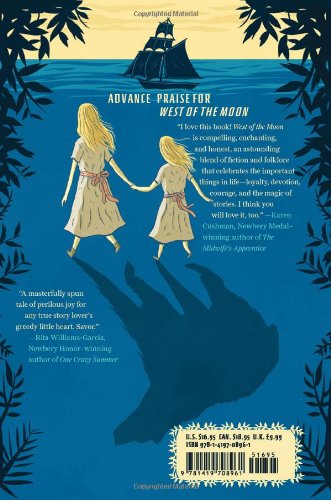
Misc: For a look behind-the-scenes of the book check out this article Award-winning Duluth author pulls from folk tales, ancestral diary for newest novel from the Duluth News Tribune.
Videos: And here’s the book trailer!
West of the Moon / Margi Preus Book Trailer from Joellyn Rock on Vimeo.


By: Carter Higgins,
on 4/30/2014
Blog:
Design of the Picture Book
(
Login to Add to MyJacketFlap)
JacketFlap tags:
color,
space,
balance,
light,
negative space,
composition,
color palette,
abrams,
layout,
nikki mcclure,
white space,
paper cut,
contrast,
collect raindrops,
design,
Add a tag

by Nikki McClure
published 2014 by Abrams Books (reissue)
Every soul who has seen Nikki McClure’s art has loved it. I’m sure there are studies and statistics on that, trust me. It looks as elegant on an iPhone case as it does on a gift tag or greeting card.
But then there are books, and thank goodness she makes them. This edition of Collect Raindrops has been reissued in an expanded form and a new format. It’s based on her ongoing calendar series, and begs to take up permanent residence on your coffee or bedside table. Don’t just stick it on the shelf. You’ll want this one at easy reach. It’s gorgeous to touch, to see, and to behold.
This edition of Collect Raindrops has been reissued in an expanded form and a new format. It’s based on her ongoing calendar series, and begs to take up permanent residence on your coffee or bedside table. Don’t just stick it on the shelf. You’ll want this one at easy reach. It’s gorgeous to touch, to see, and to behold.

 Here, her pictures are gathered by their season, each introduced with love letters to their very time and place.
Here, her pictures are gathered by their season, each introduced with love letters to their very time and place.
“Some people just need help to see the obvious. And that’s what artists are for.”
That sentiment comes from this short film that demystifies her process but reveals a lot of magic. She calls it corny, but I call it lovely:
 She says her paper cuts are like lace, and everything is connected. Before it’s in a book, can’t you picture what that art looks like held up against a light? Physically, the paper that remains envelops the paper that is gone. Like knots, or filaments, or branches. How beautiful then, that her subject is often community. Shared memories and experiences.
She says her paper cuts are like lace, and everything is connected. Before it’s in a book, can’t you picture what that art looks like held up against a light? Physically, the paper that remains envelops the paper that is gone. Like knots, or filaments, or branches. How beautiful then, that her subject is often community. Shared memories and experiences.

 The contrast is what connects us. As much story lives in what’s been carved away as what sticks behind. But by simple definition, contrast means difference, and in design, your brain is searching for dominant elements. This art contrasts light and dark, filled and white space, and in those separations paints a portrait of community.
The contrast is what connects us. As much story lives in what’s been carved away as what sticks behind. But by simple definition, contrast means difference, and in design, your brain is searching for dominant elements. This art contrasts light and dark, filled and white space, and in those separations paints a portrait of community.

 And then there’s the case cover itself. A web, a symbol itself of creativity and connection, binds the pages together.
And then there’s the case cover itself. A web, a symbol itself of creativity and connection, binds the pages together.
 Isn’t that remarkable?
Isn’t that remarkable?

Tagged: abrams, collect raindrops, contrast, light, negative space, nikki mcclure, paper cut 

By:
Danette Haworth,
on 3/18/2014
Blog:
Summer Friend
(
Login to Add to MyJacketFlap)
JacketFlap tags:
children,
Walker,
lucky,
luck,
Goodreads,
rejection,
free book,
lottery,
Bloomsbury,
Orlando,
middle,
Danette Haworth,
Abrams,
grade,
Cantor,
A Whole Lot of Lucky,
Stacy,
starred Kirkus,
title development,
Add a tag
Titles--heartache city! The title must do everything a synopsis or query does: grab the reader, provide a summary, and hint at the action yet to come. A lot of time goes into working up a good title, and it's not just the author's work, either. The editor, the editor's coworkers, and sales and marketing all have their say; everyone's input must be considered.
Titles cooked up and rejected for A WHOLE LOT OF LUCKY:
- Two Flavors of Lucky
- The Year of My Magnificent Luckiness
- Three Million Dollar Girl
- The Duplicitous Luckiness of Hailee Richardson
- Serendippitydoo
- Lucky Me
- Impossibly Possibly Lucky
- Hailee Richardson, Girl Millionaire
My editor and I brainstormed pages of titles and promptly rejected most of them. The problem lies in the word "lucky:" phrases involving "getting lucky" are imbued with the wrong kind of nuance! Also, we wanted to avoid words like jackpot or other buzzwords that are too close too gambling. (This was hard, because even the buying of a lottery ticket is gambling.)
My sister suggested "A Whole Lotto Lucky," and the powers that be loved her suggestion! With a bit of morphing, my sister's words became A WHOLE LOT OF LUCKY.
Now you can try your luck without all the heartache my editor and I went through! For a free, signed hardcover of A WHOLE LOT OF LUCKY, just enter the Goodreads contest!

By:
Betsy Bird,
on 3/12/2014
Blog:
A Fuse #8 Production
(
Login to Add to MyJacketFlap)
JacketFlap tags:
Jonathan Auxier,
Best Books of 2014,
Reviews 2014,
2014 reviews,
2014 middle grade fiction,
2015 Newbery contender,
2014 fantasy,
middle grade historical fantasy,
Reviews,
middle grade fantasy,
Best Books,
abrams,
Amulet Books,
Patrick Arrasmith,
historical fantasy,
Add a tag
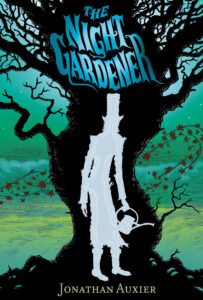 The Night Gardener
The Night Gardener
By Jonathan Auxier
Illustrated by Patrick Arrasmith
Amulet Books (an imprint of Abrams)
$16.95
ISBN: 978-1-4197-1144-2
Ages 10 and up
On shelves May 20th
For whatever reason, 2014 is a dark year in children’s middle grade fiction. I speak from experience. Fantasy in particular has been steeped in a kind of thoughtful darkness, from The Glass Sentence and The Thickety to The Riverman and Twelve Minutes to Midnight with varying levels of success. And though none would contest the fact that they are creepy, only Jonathan Auxier’s The Night Gardener has had the chutzpah to actually write, “A Scary Story” on its title pages as a kind of thoughtful dare. A relatively new middle grade author, still young in the field, reading this book it’s hard to reconcile it with Auxier’s previous novel Peter Nimble and His Fantastic Eyes. It is almost as if Mr. Auxier took his whimsy, pulled out a long sharp stick, and stabbed it repeatedly in the heart and left it to die in the snow so as to give us a sublimely horrific little novel. Long story short this novel is Little Shop of Horrors meets The Secret Garden. I hope I’m not giving too much away by saying that. Even if I am, I regret nothing. Here we have a book that ostensibly gives us an old-fashioned tale worthy of Edgar Allan Poe, but that steeps it in a serious and thought provoking discussion of the roles of both lies and stories when you’re facing difficulties in your life. Madcap brilliant.
Molly and Kip are driving a fish cart, pulled by a horse named Galileo, to their deaths. That’s what everyone’s been telling them anyway. Living without parents, Molly sees herself as her brother’s guardian and is intent upon finding a safe place for the both of them. When she’s hired to work as a servant at the mysterious Windsor estate she thinks the job might be too good to be true. Indeed, the place (located deep in something called “the sour woods”) is a decrepit old mansion falling apart at the seams. The locals avoid it and advise the kids to do so too. Things are even stranger inside. The people who live in the hollow home appear to be both pale and drawn. And it isn’t long before both Molly and Kip discover the mysterious night gardener, who enters the house unbidden every evening, tending to a tree that seems to have a life of its own. A tree that can grant you your heart’s desire if you would like. And all it wants in return? Nothing you’d ever miss. Just a piece of your soul.
For a time, the book this most reminded me of was M.P. Kozlowsky’s little known Juniper Berry, a title that could rival this one in terms of creepiness. Both books involve trees and wishes and souls tied into unlawful bargains with dark sources. There the similarities end, though. Auxier has crafted with undeniable care a book that dares to ask whether or not the things we wish for are the things best for us in the end. His storytelling works in large part too because he gives us a unique situation. Here we have two characters that are desperately trying to stay in an awful, dangerous situation by any means necessary. You sympathize with Molly’s dilemma at the start, but even though you’re fairly certain there’s something awful lurking beneath the surface of the manor, you find yourself rooting for her, really hoping that she gets the job of working there. It’s a strange sensation, this dual hope to both save the heroine and plunge her into deeper danger.
What really made The Night Gardener stand out for me, however, was that the point of the book (insofar as I could tell) was to establish storytelling vs. lies. At one point Molly thinks seriously about what the difference between the two might be. “Both lies and stories involved saying things that weren’t true, but somehow the lies inside the stories felt true.” She eventually comes to the conclusion that lies hurt people and stories help them, a statement that is met with agreement on the part of an old storyteller named Hester who follows the words up with, “But helps them to do what?” These thoughts are continued later when Molly considers further and says, “A story helps folks face the world, even when it frightens ‘em. And a lie does the opposite. It helps you hide.” Nuff said.
As I mentioned before, Auxier’s previous novel Peter Nimble and His Fantastic Eyes was his original chapter book debut. As a devotee of Peter Pan and books of that ilk, it felt like more of an homage at times that a book that stood on its own two feet. In the case of The Night Gardener no such confusion remains. Auxier’s writing has grown some chest hair and put on some muscles. Consider, for example, a moment when Molly has woken up out of a bad dream to find a dead leaf in her hair. “Molly held it up against the window, letting the moonlight shine through its brittle skin. Tiny twisted veins branched out from the center stem – a tree inside a tree.” I love the simplicity of that. Particularly when you take into account the fact that the tree that created the leaf may not have been your usual benign sapling.
In the back of the book in his Author’s Note Auxier acknowledges his many influences when writing this. Everything from Ray Bradbury’s Something Wicked This Way Comes to The Sketch-Book of Geoffrey Crayon Gent. by Washington Irving to Frances Hodgson Burnett’s simple only on the surface The Secret Garden. All these made sense to me (though I’m not familiar with the Irving yet) but I wondered if there were other ties out there as well. For example, the character of Hester, an old storyteller and junk woman, reminded me of nothing so much as the junk woman character in the Jim Henson film Labyrinth. A character that in that film also straddles the line between lies and stories and how lying to yourself only does you harm. Coincidence or influence? Only Mr. Auxier knows for sure.
If I am to have any kind of a problem with the book then perhaps it is with the Irish brogue. Not, I should say, that any American child is even going to notice it. Rather, it’ll be adults like myself that can’t help but see it and find it, ever so briefly, takes us out of the story. I don’t find it a huge impediment, but rather a pebble sized stumbling block, barely standing in the way of my full enjoyment of the piece.
In Harry Potter and the Chamber of Secrets, J.K. Rowling offers some very good advice on dealing with uncertain magical beings. “Never trust anything that can think for itself if you can’t see where it keeps its brain.” Would that our heroes in this book had been handed such advice early in life, but then I guess we wouldn’t have much of a story to go on, now would we? In the end, the book raises as many questions as it answers. Do we, as humans, have an innate fear of becoming beholden to the plants we tend? Was the villain of the piece’s greatest crime to wish away death? Maybe the Peter Pan influence still lingers in Mr. Auxier’s pen, but comes out in unexpected ways. This is the kind of book that would happen if Captain Hook, a man most afraid of the ticking of a clock, took up horticulture instead of piracy. But the questions about why we lie to ourselves and why we find comfort in stories are without a doubt the sections that push this book from mere Hammer horror to horror that makes you stop and think, even as you run like mad to escape the psychopaths on your heels. Smart and terrifying by turns, hand this book to the kid who supped of Coraline and came back to you demanding more. Sweet creepy stuff.
On shelves May 20th.
Source: Galley sent from publisher for review.
Like This? Then Try:
Professional Reviews: A star from Kirkus

Thanks to Rachel Poloski for being the 24,000th person to follow my @inkyelbows Twitter account. When I went to check her profile, I was intrigued:

Rachel was kind enough to answer some questions for Inkygirl about her work.
Q. Your profile says that you work in production at Abrams on YA and children's books. Could you possibly tell us more?
 Of course! I work specifically on Amulet Books, which is an imprint of Abrams focusing on fiction and non-fiction writing for middle grade and young adult readers. I also work on reprints across all the children's imprints; Abrams Books for Young Readers, Appleseed, and Amulet Books.
Of course! I work specifically on Amulet Books, which is an imprint of Abrams focusing on fiction and non-fiction writing for middle grade and young adult readers. I also work on reprints across all the children's imprints; Abrams Books for Young Readers, Appleseed, and Amulet Books.
I like to think of Production as the behind-the-scenes of book making. You don’t always see our names in the book or know who we are, but we are involved from start to finish. As production manager of a title, you begin by providing estimates on a book that has not yet been acquired. This enables editors, publishers, and our CEO to discuss the possibilities for the title and if it will work for Abrams. Once a book is acquired, you start forming a schedule based on a publication date or when advances of books are needed.
I work closely with Managing Editorial, Editorial, and Design to keep the schedule on track as well as start working out the book’s specifications. By this I mean the cover stock, text stock, cover effects, inks, trim size, etcetera. We also work out effects on the jacket/cover, which include lamination, embossing, glitter uv (ultra-violet coating), glow in the dark uv, metallic inks, cloth cases, and much more!
For the books I work on, this is the exciting work! Production managers have to be creative and provide ideas to editorial and design in order to bring their ideas to fruition, while maintaining a budget and schedule. Sometime we need to think outside the box and research materials or effects that will accomplish the look and feel the editor and designer desire.
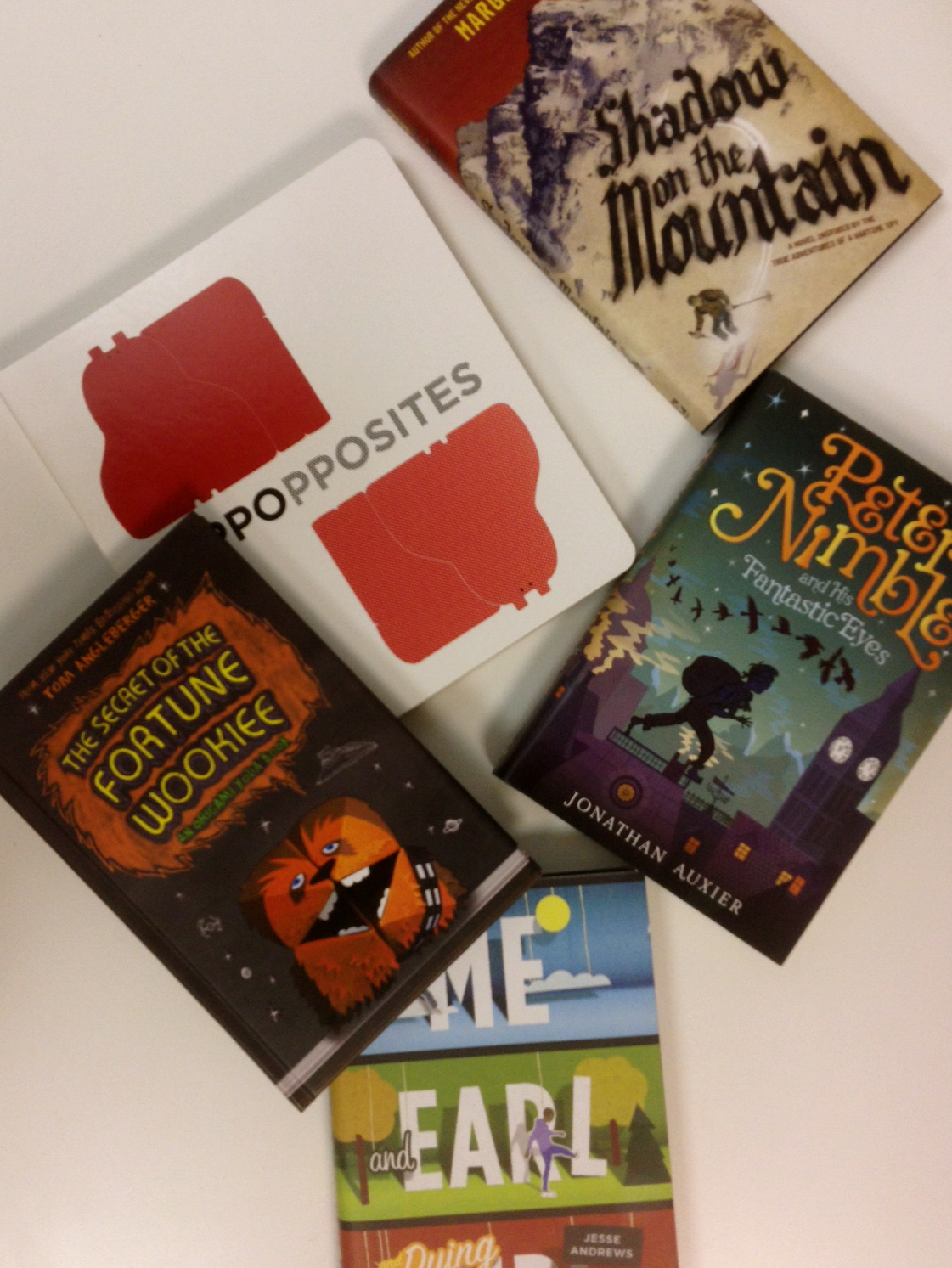 Q. What recent or upcoming Abrams books are you especially excited about?
Q. What recent or upcoming Abrams books are you especially excited about?
I am really excited about working on all my upcoming titles, but specifically I am enthusiastic to work on a new Lauren Myracle title and the final book in the NERDS series written by Michael Buckley! I also just finished working on the paperback edition of Me and Earl and the Dying Girl by Jesse Andrews, which is most definitely my favorite book published at Abrams. It is funny, endearing, unique, and moving. I also had the pleasure of running into Jesse Andrews in the Abrams elevator and he is equally as charming as his writing. He is a both kind and humble. Another hardcover to paperback title I am thrilled to work on is Roddy Doyle’s A Greyhound of a Girl. Such a fantastic book! In Spring 2014 I am also working on new books from Lisa Greenwald and Sarah Skilton, which I am also eagerly anticipating.
Q. What do you write? (aside: I notice that you're a columnist for the Abrams site, for example)
 Phillip, by Rachel PoloskiAh, yes. I do write for the Abrams blog, mostly about cooking and then there is the one of me shooting a rifle in the Adirondacks. Don’t worry; this is not a regular sport for me. I do love to cook and bake, therefore writing about it is also pleasurable. Luckily, Abram’s imprint Stewart, Tabori & Chang publishes beautiful and yummy cookbooks for me to test out in the kitchen!
Phillip, by Rachel PoloskiAh, yes. I do write for the Abrams blog, mostly about cooking and then there is the one of me shooting a rifle in the Adirondacks. Don’t worry; this is not a regular sport for me. I do love to cook and bake, therefore writing about it is also pleasurable. Luckily, Abram’s imprint Stewart, Tabori & Chang publishes beautiful and yummy cookbooks for me to test out in the kitchen!
I also do some writing personally, either about silly characters I draw or about my coveted stuffed cat, Celeste. I like to make up names and personas for the little felted creatures I hand make, but nothing that I have published or shared with the world. Maybe there will be some short stories to come soon. I recently illustrated a nervous soul named Phillip. I think I might write a little piece on him.
Q. Where can people find you online?
Twitter: https://twitter.com/rachel_poloski
Pinterest: http://pinterest.com/rachelapoloski
Instagram: http://instagram.com/rachel_anne_poloski
Etsy: http://www.etsy.com/people/rpoloski
I will hopefully have some felted creatures as well as some little felted naked people up on Etsy soon and I really would love to start my own blog. What’s stopping me you might ask? Me. Fortunately, I have slowly been putting myself out there on both Instagram and Twitter and its not so scary after all. I am proud of me and would love to share my zany thoughts.
-------
Also see other Inkygirl Interviews.
 Readers can download a free digital copy of Erin McHugh‘s One Good Deed: 365 Days of Trying to Be Just a Little Bit Better on October 12th. The free eBook will be available at Netgalley and eBook retailers.
Readers can download a free digital copy of Erin McHugh‘s One Good Deed: 365 Days of Trying to Be Just a Little Bit Better on October 12th. The free eBook will be available at Netgalley and eBook retailers.
Just like the book, the publisher hopes to encourage more positive actions through this one good deed. Readers can share their own good Samaritan stories on the “#onegooddeed” Twitter hashtag and post on McHugh’s website.
Here’s more from the release: “One Good Deed originated from a blog that McHugh started one day when she learned that a distant relative was going to be canonized. Was this a sign to reevaluate her priorities? What followed next was McHugh’s sincere urge to recapture a sense of charity, leading her to do one good deed every day for an entire year. Maybe she wouldn’t be saving orphans from burning buildings or curing cancer, but she wanted to take one small daily detour and make someone else’s life just a little bit better.”
New Career Opportunities Daily: The best jobs in media.

By:
Chad W. Beckerman,
on 9/10/2012
Blog:
Mishaps and Adventures
(
Login to Add to MyJacketFlap)
JacketFlap tags:
design,
fonts,
ideas,
typography,
Colors,
letters,
a,
Jack,
Diary of a Wimpy Kid,
awesome,
ABRAMS,
Julia Denos,
I Had a Favorite Dress,
Pantone,
Moma,
Prime meats,
Frankies,
aforabrams,
Hit the Road,
artful,
Add a tag
We over here at ABRAMS KIDS have started a campaign on Instagram and Twitter called A for ABRAMS ( #aforabrams ) We are collecting A's that are artful, well designed, or just plain cool from any where that you might find them. The idea is when ever you happen to see one of these artful A's out and about you can join us by hash tagging your A #aforabrams as well as including our Instagram or twitter handle @abramskids or @abramsbooks. Have some fun and we hope you all get to see the world around you a little better.
Here area few examples of different A's I have found.
You can find artful A's in out books!
Or on your favorite wimpy book!
Or you can be crafty and make one to hang on your window.
Or you can find one in your local Museum!
Or at your local bookstore!
Or at your favorite restaurant!
Good luck hunting! A for ABRAMS #aforbrams @abramsbooks and @abramskids
.
Food! Parties! Fun! The North County Times (North San Diego County) lists possibilities.
Meanwhile, U-T San Diego (hook ‘em horns!) showcases their coverage here.
They also tell the story of “Atomicman” and how he helped the San Diego Comic-Con move and adapt to the convention center!
The Mayor officially opens Comic-Con International!
ThinkGeek announces a Doctor Who sonic screwdriver remote control. You can order it here.
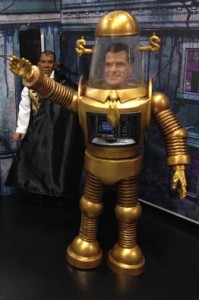 Heroes in Action announces their satirical Mitt “Romney the Robot” figure. Yes, other politicians have also been depicted…
Heroes in Action announces their satirical Mitt “Romney the Robot” figure. Yes, other politicians have also been depicted…
Heroes In Action also produces toys modeled after other presidents, including Barack Obama (“Baracula”), Bill Clinton (“Wolf Bill”), George W. Bush (“Zom-Bush”), as well as other political figures such as Secretary of State Hillary Clinton (“Hilluria, the Secretary of Stake”) and Al Gore (“Algor, An Inconvenient Assistant”).
Four people spend Comic-Con living in a car. (Big deal, I’ve seen hotel rooms sleep ten.)
Today is Super Hero Day at the LEGO booth! Here are the exclusives! Not to be offered in sets! Shazam! and Venom (or Spidey, since there’s no tongue or muscles). Bizarro and Phoenix! There are two sweepstakes URLs on the Bizarro and Phoenix pictures, but they aren’t working right now! How soon before someone constructs Bizarroworld? And then has Phoenix eat it?
Publishers Weekly announces that Abrams ComicsArts will be offering digital e-books in partnership with Comixology! The first five titles:
- My Friend Dahmer by Derf Backderf
- Empire State: A Love Story (or Not) by Jason Shiga
- Mom’s Cancer by Brian Fies
- Fairy Tales for Angry Little Girls by Lela Lee
- Cats, Dogs, Men, Women, Ninnies & Clowns: The Lost Art of William Steig by Jeanne Steig with Illustrations by William Steig
And here’s a cool discovery… just up the road in Riverside! The University of California at Riverside has the Eaton Collection
| Title: Black Elk’s Vision: A Lakota Story Author: S D Nelson Publisher: Abrams |
May Contain Spoilers
From Amazon:
| Told from the Native American point of view, Black Elk’s Vision provides a unique perspective on American history. From recounting the visions Black Elk had as a young boy, to his involvement in the battles of Little Big Horn and Wounded Knee, as well as his journeys to New York City and Europe with Buffalo Bill’s Wild West Show, this biographical account of Black Elk—an Oglala-Lakota medicine man (1863–1950)—follows him from childhood through adulthood. S. D. Nelson tells the story of Black Elk through the medicine man’s voice, bringing to life what it was like to be Native American in the mid-to-late nineteenth century and early twentieth century. The Native people found their land overrun by the Wha-shi-choos, or White Man, the buffalo slaughtered for sport and to purposely eliminate their main food source, and their people gathered onto reservations. Through it all, Black Elk clung to his childhood visions that planted the seeds to help his people—and all people—understand their place in the circle of life. The book includes archival images, a timeline, a bibliography, an index, and Nelson’s signature art. |
Review:
I read two books recently about young children victimized by war, and they both broke my heart. In Black Elk’s Vision, a picture book based on Black Elk Speaks by John Neihardt, warfare destroys not only Black Elk’s home, but also his people’s entire way of life. From the cover to the last page, this colorful book is striking and thought provoking. It doesn’t pull any punches, either. From Little Big Horn to the massacre at Wounded Knee, Black Elk’s story is compelling and unforgettable. From the vast plains, hunting buffalo, to the hardship of a walled reservation, his words remain steady and engrossing. I am not sure that I would be as forgiving as Black Elk, Great Vision or not. Manifest Destiny is such an ugly chapter in the history of this country, and I find it painful to read many accounts of settlers as they steamrolled over everything in their path to conquering the West.
There are several parts of this book that I found disturbing, and I am sure that I will find them hard to forget. Before the white settlers flooded like a tsunami over the Great Plains, there were an estimated 30 million bison. Thirty million. By 1889, there were about a thousand. The numbers are mind-numbing. Worse, diseases brought by Europeans wiped out hundreds of thousands of Native Americans. And that was before the settlers began to intentionally drive them off of their ancestral homelands. Thinking about the massive loss of life is nauseating. Thinking about a twelve year old boy forced to defend his life, as well as the lives of his family, is also upsetting. Thinking about having everything you owned, every belief and physical possession, even your way of life, torn away also merits deep contemplation. I would not have survived nearly as well, or lived nearly as gracefully, as Black Elk.
I found Black Elk’s Vision a compelling read. Interspersing colorful acrylics with vintage photos of the events described in Black Elk’s narrative, I found t
.
 Book Expo America 2012 just concluded here in New York, and once again it’s been an interesting trade show. Some stuff was normal, some was new, and overall, I felt it was a good show. My thoughts and discoveries follow.
Book Expo America 2012 just concluded here in New York, and once again it’s been an interesting trade show. Some stuff was normal, some was new, and overall, I felt it was a good show. My thoughts and discoveries follow.
✐
One interesting, if under-reported, improvement was the “Power Reader” program. On Thursday, the last day of the show, when most attendees are winding down, BEA invited “power readers” to attend. Twelve local independent bookstores and the New York Public Library invited their best customers to pay $45 to attend the show on Thursday. What did they get? I quote:
- Discover new and upcoming books before they hit the stands
- See and meet your favorite authors
- Talk to publisher about favorite books and authors
- Mix and Mingle with other book lovers and share your passion for reading
- Get autographs and advanced reads of unique books (quantities limited)
- Get tons of giveaways from exhibitors. [62 different promos]
 Get a FREE POWER READER SWAG BAG at registration, filled with goodies like:
Get a FREE POWER READER SWAG BAG at registration, filled with goodies like:
- An advance copy (before books even hit shelves!) of an upcoming title from one of today’s hottest authors, including Debbie Macomber’s Inn at Rose Harbor, Dean Koontz’s Odd Apocalypse, and Karin Slaughter’s Criminal
- A special edition copy of Justin Cronin’s bestselling sensation The Passage
- A sampling of recipes from beloved QVC host David Venable’s first cookbook, In the Kitchen with David®
- A Janet Evanovich magnet
- A Debbie Macomber keychain
- A sneak peek guide with the early scoop on forthcoming releases from bestselling authors
When BEA moved to the middle of the week (Monday-Thursday, instead of Wednesday-Sunday), I thought that BEA would be planning a weekend “Book-Con” for the general public. After all, Reed runs BEA, and they’ve got experience running New York Comic Con at the same location. They could arrange booths so that a wall could be set up to reduce the size of the show (or they could fill booths vacated by trade exhibitors with retail exhibitors the next day). The possibility of a huge weekend crowd (if 100,000 attend NYCC, how many romance, mystery, and science fiction fans would attend a book show, especially to discover new titles and meet authors (just like Comic-Con!)?) might reinvigorate the show, encouraging lapsed publishers to return to the show (or risk ending up on a waiting list, like at San Diego).
Would it be hard for publishers to shift from trade to retail? Not really. Most of the mainstream publishers sell books at the American Library Association shows. Ever
View Next 25 Posts
 The Mighty Odds
The Mighty Odds Lest we forget, this is an illustrated novel. Ignatow makes the somewhat gutsy choice of not explaining the art for a long time. Long before we even get to know Martina, we see her in various panels and spreads as an alien. In time, we learn that the art in this book is all her art, and that she draws herself as a Martian because that’s what her sister calls her. Not that you’ll know any of this for about 125 pages. The author makes you work to get at that little nugget of knowledge. By the way, as a character, Martina the artist is fascinating. She’s sort of the Luna Lovegood of the story. Or, as Nick puts it, “She had a sort of almost absentminded way of saying things that shouldn’t have been true but probably were.” There is one tiny flub in the art when Martina draws all the kids as superheroes and highlights Farshad’s thumbs, though at that point in the storyline Martina wouldn’t know that those are his secret weapons. Other than that, it’s pretty perfect.
Lest we forget, this is an illustrated novel. Ignatow makes the somewhat gutsy choice of not explaining the art for a long time. Long before we even get to know Martina, we see her in various panels and spreads as an alien. In time, we learn that the art in this book is all her art, and that she draws herself as a Martian because that’s what her sister calls her. Not that you’ll know any of this for about 125 pages. The author makes you work to get at that little nugget of knowledge. By the way, as a character, Martina the artist is fascinating. She’s sort of the Luna Lovegood of the story. Or, as Nick puts it, “She had a sort of almost absentminded way of saying things that shouldn’t have been true but probably were.” There is one tiny flub in the art when Martina draws all the kids as superheroes and highlights Farshad’s thumbs, though at that point in the storyline Martina wouldn’t know that those are his secret weapons. Other than that, it’s pretty perfect.











































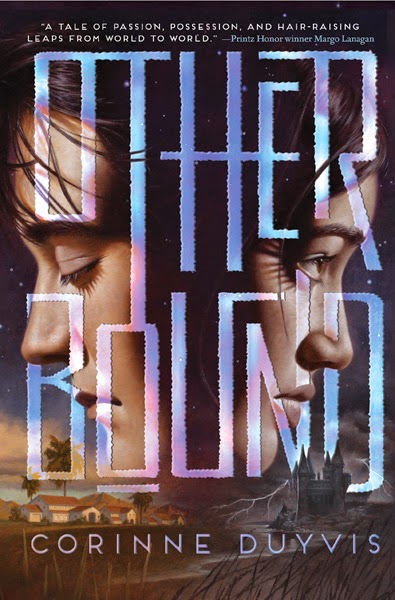


















 Readers can download a free digital copy of Erin McHugh‘s One Good Deed: 365 Days of Trying to Be Just a Little Bit Better on October 12th. The free eBook will be available at Netgalley and eBook retailers.
Readers can download a free digital copy of Erin McHugh‘s One Good Deed: 365 Days of Trying to Be Just a Little Bit Better on October 12th. The free eBook will be available at Netgalley and eBook retailers.















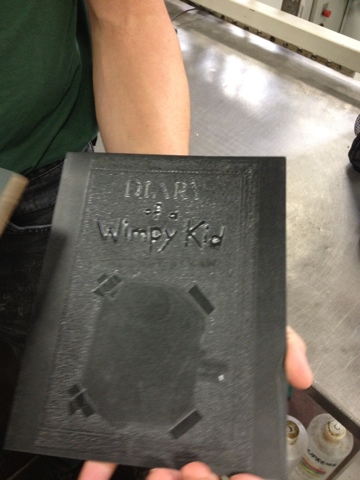




 Get a FREE POWER READER SWAG BAG at registration, filled with goodies like:
Get a FREE POWER READER SWAG BAG at registration, filled with goodies like:
[…] Source link […]
[…] Source link […]